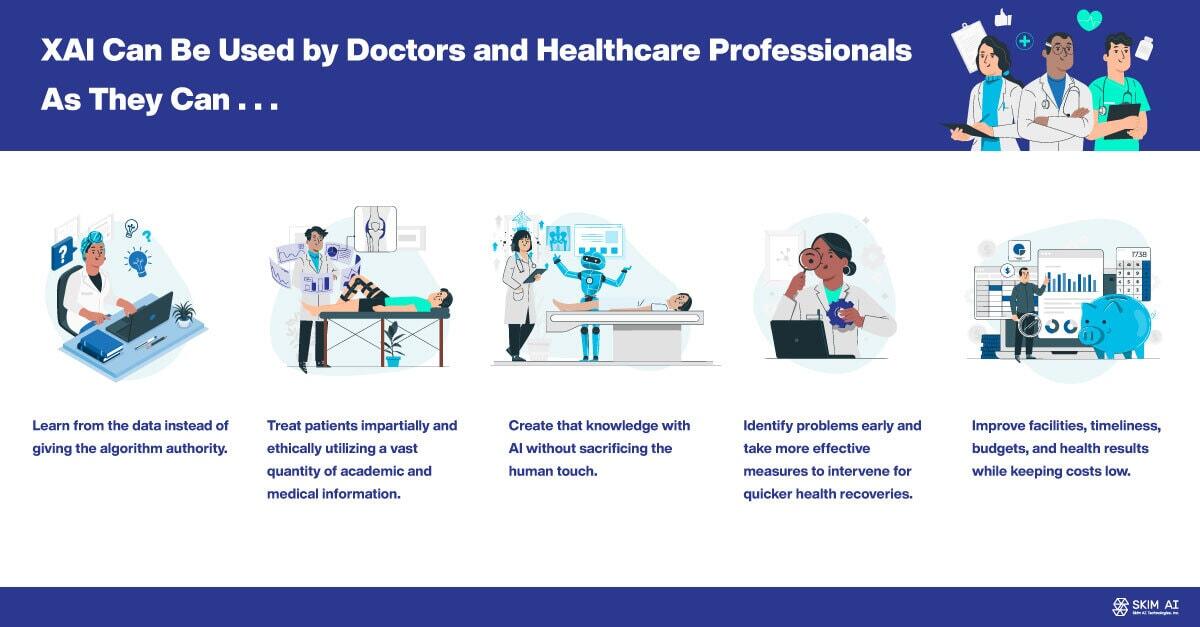How Healthcare Could Use Explainable AI?
How Healthcare Could Use Explainable AI?
Healthcare, finance, insurance, and manufacturing are just a few industries where artificial intelligence (AI) greatly impacts. More complex AI models are being developed to meet the requirements of particular use cases. However, these AI models’ predictions appear to be "Black-box" outputs, lacking any justification or explanation for why they were made. The necessity for researchers, organizations, and regulators to comprehend how AI models are completely giving suggestions, forecasts, etc., gave rise to Explainable AI (XAI).
Explainable artificial intelligence (XAI) is one of the newest and fastest-growing branches of artificial intelligence. The XAI approach aims to offer a human-understandable explanation for the deep learning model. In safety-critical industries like healthcare or security, this is extremely crucial. The approaches put forth in the literature over the years frequently claim that they will answer the query of how the model arrived at its conclusion straightforwardly.
Understanding When XAI is Necessary For Healthcare
Healthcare professionals use AI to expedite and enhance various functions, including risk management, decision-making, and even diagnosis, by scanning medical pictures to find invisible anomalies and patterns to the human eye. Although AI has become a vital tool for many healthcare professionals, it is difficult to understand, which frustrates providers, especially when making important decisions.
Any of The Following Scenarios Require XAI
- When fairness is a top priority and when customers or end users require information to make an informed choice
- When poor AI judgment has broad-reaching effects (such as a recommendation for unnecessary surgery)
- When the consequences of a mistake are severe, such as misclassifying malignant tumors results in excessive financial charges, increased health risks, and personal trauma.
- When an AI system creates a new hypothesis that needs to be tested by specialists in a particular field.
- For the goal of complying with regulations, such as the General Data Protection Regulation (GDPR) of the EU, which guarantees the “right to an explanation” when automated processes process user data
According to several experts, the relatively delayed adoption of AI systems in the healthcare industry is due to the near impossibility of independently confirming the outcomes of black box systems.
However, clinicians can use XAI to determine the best course of treatment for a patient by determining why they have such a high risk of hospital admission. As a result, physicians can base their decisions on more trustworthy information. Additionally, it enhances clinical decisions’ traceability and transparency. The approval process for pharmaceuticals can also be accelerated with XAI.
How Can Doctors Benefit From XAI?

Many people’s wrist watch heart monitors may melt at the thought of implementing AI in healthcare, but we think a fully explicable and moral approach will be the pacifier. It will imply that a wealth of historical patient and clinical data can be utilized to help doctors and other healthcare professionals learn from the AI in addition to helping the AI inform care plans.
It will make it possible for an effective, data-driven process that evaluates and calibrates the entire algorithm whenever a new treatment option becomes available and allows for traceable, individualized programs for every patient. To continually improve its recommendations to doctors, it will combine data from thousands of individuals with nearly comparable diseases.
XAI Can Be Used By Doctors And Healthcare Professionals As They Can
- Learn from the data instead of giving the algorithm authority.
- Treat patients impartially and ethically utilizing a vast quantity of academic and medical information.
- Create that knowledge with AI without sacrificing the human touch.
- Identify problems early and take more effective measures to intervene for quicker health recoveries.
- Improve facilities, timeliness, budgets, and health results while keeping costs low.
Conclusion
When it comes to sustainable digital transformation, many organizations already take advantage of the exponential growth in technology. There has never been a better time for healthcare providers and businesses in the life science and biotech sectors to do the same as we all look for better ways to operate in the wake of a turbulent few years.
Solutions for explainability can help healthcare professionals keep their confidence while they explore innovation. In addition, when governments impose rigorous regulations on healthcare technology, explainability may be a crucial first step in cracking open the AI black box and making model decision-making clear to all stakeholders.






